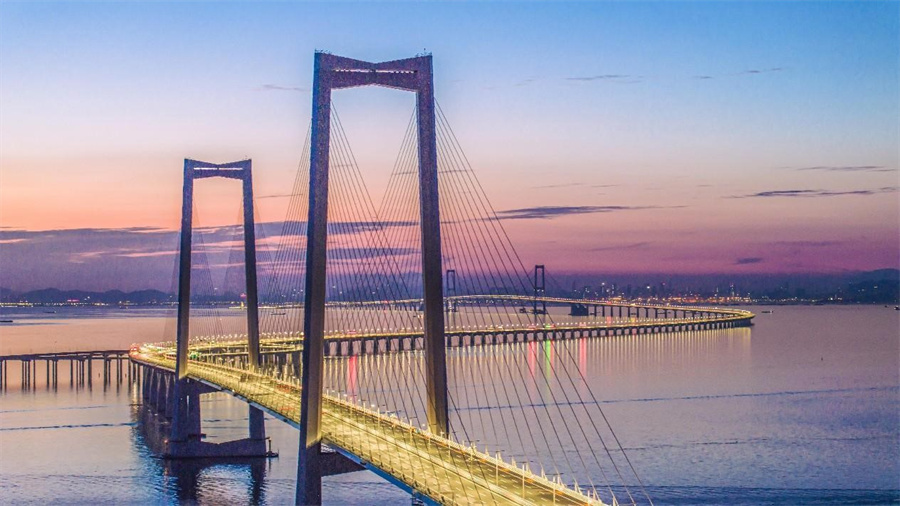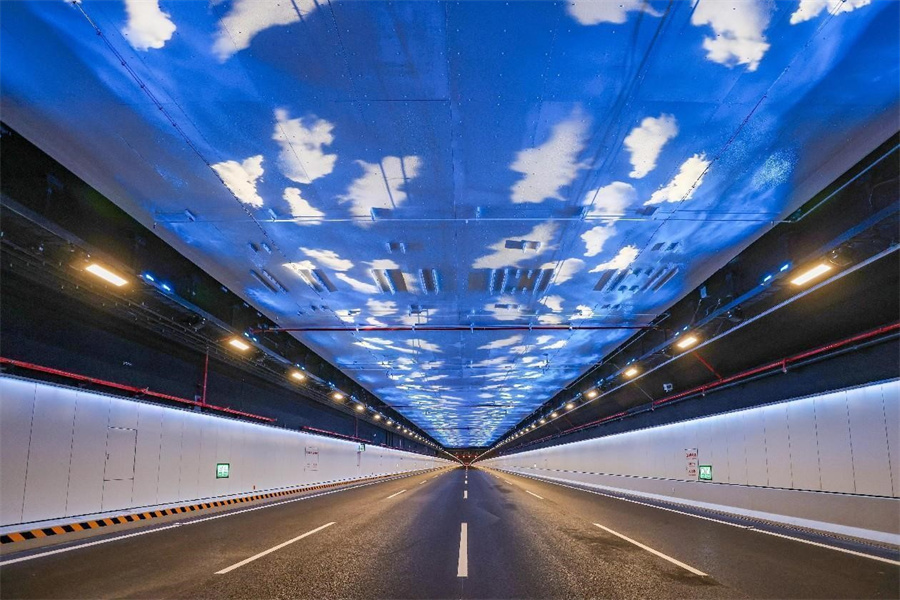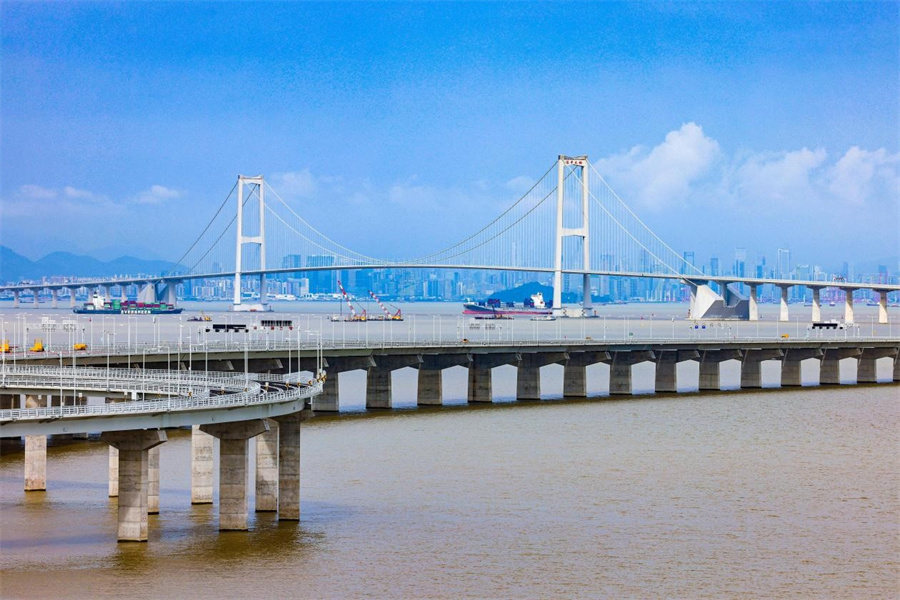Innovative technologies contribute to China's latest mega cross-sea link
The Shenzhen-Zhongshan Link, a mega cross-sea passage in south China, had handled 305,000 vehicles as of July 3, according to data from China's Guangdong Transportation Group.
The 24-kilometer passage was officially opened to traffic on June 30, representing the world's first cross-sea cluster project that features two bridges, two artificial islands and an underwater tunnel. Bridging Shenzhen in the east of the Pearl River Estuary with Zhongshan in the west, it has significantly reduced travel time between the two cities from about two hours to around 30 minutes.

Photo shows the Shenzhen-Zhongshan Link. [People's Daily Online/Fu Haiyan]
The massive transportation project commenced construction in February 2017 and took over seven years to complete. It utilized a number of new technologies, equipment, materials, and processes, managed to overcome multiple world-class technical challenges and set multiple world records.
The link features a two-way, eight-lane tunnel that spans 6.8 kilometers under the sea, consisting of 32 immersed tubes and one final closure joint. It is the world's longest and widest underwater steel-shell concrete tunnel, also one of the most challenging projects worldwide.
Viewed from above, the Shenzhen-Zhongshan Bridge, one of the key projects of the link, resembles the majestic backbone of a dragon.
Such magnificence meant unprecedented technological challenges met by engineers during the construction, said Song Shenyou, head of the Shenzhen-Zhongshan Link administration center of Guangdong Provincial Communications Group Co., Ltd., also chief engineer of the project.
According to Song, one of the primary focuses during construction is to ensure that ships can navigate in and out of the Pearl River Estuary, as the link serves as a core transportation hub project in the bustling Guangdong-Hong Kong-Macao Greater Bay Area, a major center for foreign trade in China.
To facilitate smooth ship navigation, the Shenzhen-Zhongshan Bridge, with a main span of 1,666 meters, adopts the offshore steel box girder suspension bridge design, also the world's largest of its kind. It boasts the highest bridge deck of 91 meters and the highest air traffic clearance altitude of 76.5 meters worldwide.

Photo shows the underwater tunnel of the Shenzhen-Zhongshan Link. [People's Daily/Zhang Wujun]
However, the bridge also faces substantial obstacles in wind resistance as it is located in the open waters of the Pearl River Estuary, which is prone to strong typhoons.
To tackle these challenges, the Shenzhen-Zhongshan Link administration center collaborated with multiple universities and research institutions, conducting research for over three years. Together, they have developed a new combined aerodynamic control technology that has greatly enhanced the wind resistance capabilities of the large-span steel box girder suspension bridge. The highest flutter critical wind speed for the bridge has been lifted to 88 meters per second.
The Shenzhen-Zhongshan Link has achieved full 5G coverage, providing passengers with strong signals throughout their journey, whether on the open sea or in the extraordinarily long underwater tunnel.
The ceiling of the underwater tunnel features an artfully designed motif with blue skies and white clouds. This eye-catching display is created by an array of uniquely shaped, colorful lights arranged at different angles. Apart from being visually appealing, such a unique design also serves practical functions such as safety guidance and color-coded alerts.
On the west artificial island of the project, there is a 55-meter-tall ventilation tower, the tallest single structure on the island. It functions as the "respiratory system" for the entire tunnel, said Zhu Dingtao, an engineer with the Shenzhen-Zhongshan Link administration center. Positioned near the tunnel entrance, the tower works with axial fans to expel exhaust gas from the tunnel; in case of a fire, it can quickly remove smoke from the immersed tube, added Zhu.
In addition to the ventilation tower, there is a central utility tunnel that runs between the two-way traffic lanes of the underwater tunnel. It serves as the "nerve center" of the entire structure, home to various equipment including power supply, water supply and drainage, fire protection, communications, and intelligent control facilities. It also acts as a crucial emergency escape route, allowing people to access the opposite traffic lane for evacuation in case of emergencies.

Photo shows the Shenzhen-Zhongshan Bridge of the Shenzhen-Zhongshan Link. [People's Daily/Zhang Wujun]
In the command center of the Shenzhen-Zhongshan Link, there is a digital twin platform developed in tandem with the project. This platform uses precise 3D simulation modeling technology to recreate a 1:1 scale replica of the physical environment of the bridges, artificial islands, and tunnel of link. It provides a real-time, 24-hour view of vehicle traffic and includes smart management functions such as intelligent vehicle tracking, driving behavior analysis, and monitoring of vehicles carrying hazardous materials.
During the construction of the link, an array of cutting-edge technologies have been employed to ensure safety and efficiency.
For instance, a network of fixed cameras has been installed throughout the tunnel to identify overheating vehicles before they enter the tunnel, track them in the tunnel and make immediate response if emergencies happen.
Weather sensors and meteorological radar systems have been installed to monitor meteorological conditions in real time. The information they obtained is then combined with weather forecasting data to predict potential weather-related hazards. This integrated approach allows for early detection of adverse weather conditions that could affect driving safety on the bridge sections and artificial islands.
Besides, there are 14 intelligent inspection robots capable of collecting data on the tunnel's environment and the conditions of its equipment and facilities.
All these advanced systems allow for rapid coordination with nearby fire and rescue services, traffic police, medical units, and emergency response units to ensure driving safety.
























